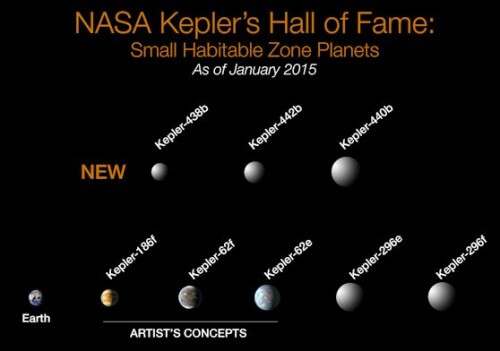Six of the confirmed planets and at least three of those still being tested are similar in size to Earth and in the habitable zone of their suns.

How many stars host planets like Earth? The Kepler space telescope regularly monitors over 150 stars and has so far indicated for scientists about 4,000 candidate planets for testing, indicating the confirmation of the thousandth planet.
Scientists poring over the Kepler data reached this milestone after confirming that eight more candidates had been spotted in the area the telescope was looking at. In fact, the Kepler team added 554 new candidates to the list of potential planets, six of which are close in size to Earth and in orbits that place them in the habitable zone around stars similar to our Sun.
Three of the newly confirmed planets are located in their sun's habitable zones, the range of distances from the star where liquid water might exist on the planet's surface. Of the three, it is estimated that two are composed of rocks, like the Earth.
"Each find of the Kepler planet hunter is a treasure trove of information that brings us one step closer to answering the question of whether we are alone in the universe," says John Grunsfeld, NASA's assistant administrator for science missions at the agency's headquarters in Washington. "The Kepler team and its scientific community continue to generate results from the data of this amazing spacecraft."
To determine whether a planet is made of rocks, water or gas, scientists must know its size and mass. When its mass cannot be determined directly, they are forced to determine its composition based only on its size. Two of the recently confirmed planets, Kepler 438b and Kepler 442b, are less than 1.5 times the diameter of Earth. Kepler 438b is 475 distant, 12% larger than Earth and orbits its sun once every 35.2 days. Kepler 442b is 1,100 light years from Earth and is 33% larger than Earth and orbits its Sun once every 112 days.
These two planets orbit smaller, colder suns than our sun, a fact that brings the habitable zone closer to the parent star. Both are in the direction of the constellation Nebula (the area Kepler observed).
"With each new discovery of small and most likely rocky planets, our understanding of the frequency of the invention of Earth-like planets is strengthened," says Doug Caldwell, an astronomer at the STS Institute and NASA's Ames Center in California. "The day when we will know how common rocky planets like Earth are is on the horizon."
The addition of the additional 554 candidates from Kepler observations made from May 2009 until it broke down in April 2013 brings the total number of candidates to 4,175. Eight of them have a diameter of up to twice the diameter of the Earth and are at a similar distance from the Sun in terms of size and temperature. All candidates require follow-up observations and analysis to confirm that they are indeed planets.
"Kepler collected data for four years - a long enough time to discover planets the size of Earth and in orbits similar to his own." Says Fargal Mulali, he is also a researcher at the STE Institute and NASA's Ames Space Center. "We are closer than ever to discovering a twin to Earth in other solar systems. These are the planets we are especially looking for."
The work on translating the latest discoveries into estimates of the prevalence of rocky planets in the habitable zone of Sun-like stars is a significant step towards NASA's goal of understanding our place in the universe.
The studies describing both discoveries have been accepted for publication in the Astrophysical Journal.

7 תגובות
Avi Blizovsky,
Some spelling errors and missing sentences need to be corrected:
I have an idea, maybe add a window next to each article where you can report errors in the article, and they will reach you directly, without the need for others to read them as a response?
Please correct:
Fifth paragraph: "Kepler 438b is 475 away," add "light years."
In the same paragraph: "Kepler 442b remote 1,100" change to "remote".
Eyal
Ha ha the planet Malamack…
Avi Blizovsky,
Some spelling errors and missing sentences need to be corrected:
I have an idea, maybe add a window next to each article where you can report errors in the article, and they will reach you directly, without the need for others to read them as a response?
Please correct:
Fifth paragraph: "Kepler 438b is 475 away," add "light years."
In the same paragraph: "Kepler 442b remote 1,100" change to "remote".
I thought for a moment that he discovered the planet of a thousand 🙂
http://upload.wikimedia.org/wikipedia/he/6/62/ALF.jpg
to a colleague,
We've been doing things like this for decades (SETI):
http://en.wikipedia.org/wiki/Search_for_extraterrestrial_intelligence
So far without success.
Question - Is it possible to "find out" a search for radio waves? That is, can we check if a specific planet emits (or emitted) radio waves? Or will the waves we are looking for be picked up arbitrarily and it will not be possible to know what their source is?